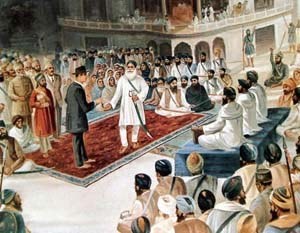BACHITTAR SINGH, BHAI (d. 1921), was a granthi (officiant) at the gurdwara in Chakk No. 85 Dalla Chanda Singhvala in Sheikhupura, in the newly colonized irrigation district in western Punjab. Nothing is known about his parentage or the date and place of his birth. He had arrived at the village in the company of a Nanga sadhu as a boy of 10 or 12 years and had stayed on in the local gurdwara. He had learnt to read Gurmukhi and the holy text from the granthi whom he replaced after the latter had left.
BAGGA SINGH, BHAI (1893-1921), was born during Assu 1950 Bk/September-October 1893, the son of Bhai Ganga Singh and Mai Mallan, a peasant couple of Chakk No. 38 Deva Singhvala in Sheikhupura district, in the newly developed canal area in western Punjab by the British. He learnt reading and writing in Gurmukhi script from the village granthi and took the initiation of the Khalsa at the age of 18. He was of a lissom athletic build interested in village sports and was also a member of the village holy choir.
BUDDH SINGH. BHAI (1903-1921), son of Bhai Surjan Singh and Mat Ganga Kaur was born on 4 January 1903 at village Kartarpur in Sialkot district. The family descended on the paternal side from Bhai Alam Singh Nachana, a prominent Sikh in Guru Gobind Singh`s retinue. Young Buddh Singh shared his elders` religious fervour and also received formal education up to the middle school standard. At the age of 15, he accompanied his parents on a pilgrimage to Sachkhand Sri Hazur Sahib, Nanded, where he received the vows of the Khalsa and donned a Nihang`s uniform. He organized a kirtanijatha (choir) and began preaching the Guru`s teachings.
CHARAN SINGH. BHAI (d. 1921), one of the Nankana Sahib martyrs, was the son of Bhai Gokal Singh and Mai Lachhman Kaur of Diriga village, in Gujrat district. He lost his mother during infancy. His old grandmother looked after him for about five years and was then sent to live with his maternal aunt in a village in Lyallpur district where a childless neighbour Bhai Piara Singh adopted him as his son. He took the vows of the Khalsa at the age of 15. He adopted tattooing as a profession.
CHARAN SINGH, BHAI (1902-1921), son of Bhai Gurdit Singh and Mai Sada Kaur of the village of Kotla Santa Singh in Sheikhupura district, now in Pakistan, was born on 12 Maghar 1959 Bk/26 November 1902. His original name was Karnail Singh and he was renamed Charan Singh when he received the vows of the Khalsa. He attended the village primary school. He had a musical voice and got up a dhadi jatha (band of preachers singing heroic ballads from Sikh history to the accompaniment of small tambourines called dhads and a sarangi, a stringed instrument). He himself played the sarangi.





